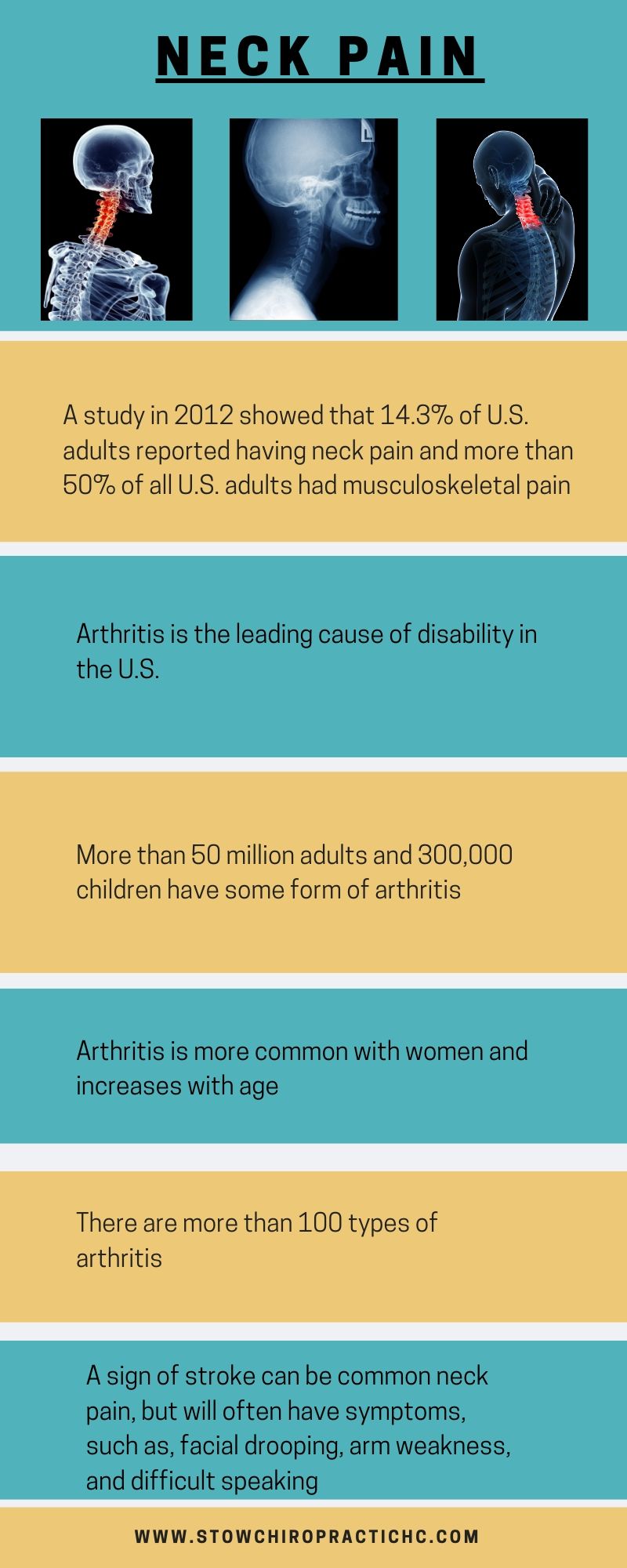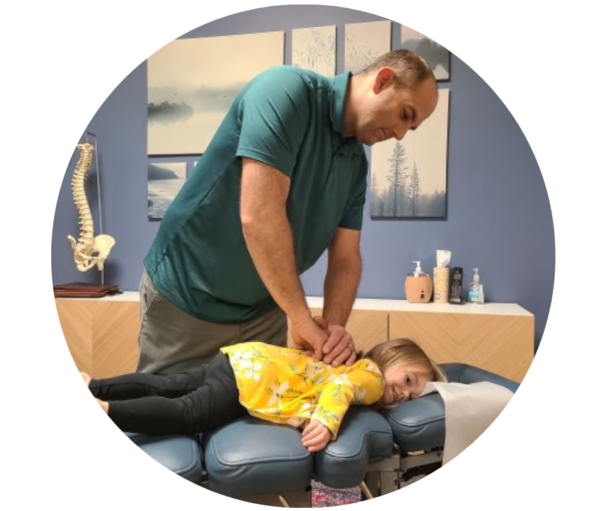Neck pain is a nuisance, causing you to become distracted throughout the day. In some people neck pain can be quite debilitating. Whether it be from sleeping in the wrong position at night, some type of injury, or an ongoing daily problem that has been present for years, neck pain ruins your day!
Many people turn toward medications to help deal with this problem, which can help reduce the inflammation, but does not address the structural problems contributing to the pain itself. Inflammation is a major factor in causing pain, but the real question that should be asked is what is causing the inflammation? Reducing the inflammation can in turn reduce the pain, but why not look at the source of the inflammation?
There are several different causes of neck pain including arthritis, muscle strains, trauma, nerve compression, diseases, weak muscles of the neck/upper back, tight muscles of the neck/upper back/chest, and other conditions. Most cases of neck pain respond well to conservative treatment methods.
What is Upper Cross Syndrome?
Upper cross syndrome is a postural problem in which the muscles of the upper back (upper trapezius and levator scapulae) and chest (pectoralis) become tight. Muscles of the front of the neck (neck flexors) and the midback (rhomboids and serratus anterior) become stretched, strained, and weakened. This is a typical problem for people who have desk jobs or work on their computer at home.
A simple stretch called Bruggers exercise can help ease the tension in the neck and upper back. To do this exercise, sit up straight, roll your shoulders back, tuck in chin and bring arms to your side with your palms out. You will hold this position for about 15 seconds, and then repeat periodically throughout the day.
Pillows and Neck Pain:
If you have ever had neck pain in the past, and have slept in a hotel with a different pillow, this may have caused your neck to “stiffen up.” There are a lot of behaviors that you can do at home or work to bring about neck pain, and having a pillow that does not fit your body properly is one of these behaviors you can address to help with your pain. Having a pillow that does not fit properly can cause a lot of stress on your neck.
Finding the right pillow can be difficult. There are companies that can custom fit your pillow based on measurements of your neck (one example is a company called “pillowise”). Other companies take a more standard approach, only differing in firmness levels of their pillows, while keeping the pillow the same shape for everyone. Another company called “core products” has a pillow with an indentation in the center, but raised around the edges. This type of pillow cradles the head while supporting the neck for people who sleep on their back or side.
Sleeping positions can also cause strain on your neck. Sleeping on your stomach may
take stress off of your lower back, but will add stress to your neck and upper back. When sleeping on your stomach, you will naturally turn your head (so you can breath better) and this causes a “twist” in the spine (neck and upper back). Sleeping on your side or back is more ideal, especially if you suffer from neck pain. Studies have also shown that people who suffer from sleeping problems (difficulty falling asleep, problems staying asleep, and people with sleep apnea) are more at risk for neck and back pain.
Arthritis:
According to Arthritis Foundation, arthritis is not a single disease, but consist of more than 100 different types. Arthritis is a simple way of referring to joint pain or joint disease. Common symptoms of arthritis are swelling, pain, stiffness and decreased range of movement. Symptoms can range from moderate to severe.
Osteoarthritis is the most common form of arthritis. When the cartilage (substance on the ends of bones) wears down, the ends of the bones can begin to rub together, resulting in pain, swelling and stiffness. People who are more at risk to this type of arthritis include family history, excess weight, age, and a past injury. Things you can do to manage osteoarthritis include a balance of activity with rest, using heat/ice, regular physical activity, maintaining a healthy weight, avoiding excessive repetitive movement, etc. (1).
Whiplash injuries:
Whiplash is an injury to the soft tissues of the neck, and is characterized by symptoms followed by damage of the neck. The injury usually occurs after a forceful and sudden extension and flexion of the neck. The injury is usually a result of a car accident. The symptoms may come on quickly or might not occur until several days. Symptoms can include headaches, neck stiffness, dizziness, burning, or neck and back pain. Treatment and recommendations given by medical physicians include pain medications, NSAIDs (nonsteroidal anti-inflammatory drugs, antidepressants, muscle relaxers, and a cervical collar (2).
Torticollis:
Torticollis, Wry neck, or Loxia are terms used to describe a condition involving muscles of the neck that prevent or limit motion beyond their normal movement. The neck will usually be twisted to one side, causing a head tilt. There are several causes including a family history of this condition, trauma related, or a reaction from medication. The muscles of the neck on the affected side of the neck are often tender to the touch. (3).
When should you be concerned about your neck pain?
There are certain causes of neck pain referred to as “Red Flags” indicating that you should seek medical attention for your neck pain. These are some causes that should prompt you to seek medical attention:
- If your pain is bothering you for more than 6 weeks (and not getting any better)
- Severe neck pain that is not improving or even getting worse
- Pain after trauma
- When light tapping on the spine produces pain
- A severe headache with difficulty bending the head forward accompanied with fever and altered mentle state
- Artery tears can cause symptoms of severe throbbing/constrictive pain that occurs suddenly and on one side of the neck, causing both neck pain and headaches
- Symptoms involving spinal cord problems: poor hand coordination, weakness, heaviness, muscle tone decreasing (atrophy), and shooting pain going into the limbs while bending your head to look down.
- Unexplained symptoms of dizziness, nausea, and vomiting
- Autoimmune conditions: before the age of 40, morning stiffness, pain in other joints, rashes, trouble with digestion, and irritated eyes (4)
A serious cause of neck pain, although less common, includes symptoms associated with stroke. You can use the acronym “F.A.S.T.” to help detect common symptoms of stroke. This stands for face drooping, arm weakness, speech that is slurred, time to call 911 (even if these symptoms go away). Ask the person to smile looking for one side of the mouth to appear uneven or lopsided. Ask the person to raise both arms (does one fall down?). Ask the person to say a simple sentence (are they hard to understand?). These symptoms can be a sign of a stroke and you need to seek immediate medical attention (5). These symptoms may or may not occur following forceful trauma to the head or neck (which can cause damage to blood vessels and initiating a stroke).
Some people can also get symptoms of a stroke, confused with another condition called “bell’s palsy” affecting nerves of the face and also causes facial drooping/numbness. The difference is that bell’s palsy will occur on the entire half of the face, and with a stroke, you will typically have face drooping on half of the face below the eyelid. In other words, look to see if the eye lid is affected. In either case, it is a wise decision to seek medical help for these symptoms.

Chiropractic and other natural treatments for neck pain:
Chiropractic can help with neck pain by improving better range of motion in the neck by chiropractic adjustments. When joints are moving properly, this will result in less inflammation of the body and can reduce pain. There are many reasons why joints of the neck become “restricted” and do not move as well as they should. When the joint does not move as intended, this results in “jamming” of the joint and causes pain, inflammation, and many other symptoms. As a joint moves, there is fluid that passes in between joints (called synovial fluid) and this brings nutrients to the surrounding cartilage (or coverings at the end) of joints. If a joint is not moving properly, then this fluid cannot move properly to the cartilage at the ends of joints, and can cause a breakdown of the cartilage leading to arthritis. Chiropractic is all about motion!
Massage therapy is another natural form of therapy that can help with neck pain. Massage therapy can help reduce muscle tension and “loosen” areas of the body. When a muscle is tight, there is less blood flow to that muscle, and this can put strain on the joints of the neck (and other areas of the body). Massage therapy can help to relax these muscles and help to circulate blood throughout the body, resulting in a reduction of pain.
Acupuncture is a therapy involving very thin needles placed strategically throughout the body to reduce pain and other symptoms. This therapy uses meridian (energy) channels to help with pain and other symptoms. Functional MRI studies have shown the acupuncture needles placed in certain areas of the body stimulate specific regions of the brain.
Structural problems and other aggravating factors of neck pain:
Arthritis and bone spurs can aggravate the neck and can cause pain, numbness and tingling, and other types of symptoms. X-rays can help to show these arthritic conditions. Although this can be an obstacle in healing, patients can still respond well to conservative treatment options.
Scoliosis and structural changes that affect the normal shape of the curve of the neck can aggravate the surrounding muscles of the neck and contribute to pain. There are certain types of stretches and techniques to help to make changes in the shape of the spine to aid in healing.
References:
1) Arthritis Foundation. https://www.arthritis.org/about-arthritis/understanding-arthritis/what-is-arthritis.php
2.) National Institute of Neurological Disorders and
Stroke. March 27, 2019. https://www.ninds.nih.gov/disorders/all-disorders/whiplash-information-page
3.) Cunha, John and Davis, Charles. Torticollis (Wry Neck In Babies, Children, and Adults. Sept 30, 2019.
https://www.emedicinehealth.com/torticollis/article_em.htm#what_is_torticollis
4.) Ingraham, Paul. When to worry about neck pain…and when not to! Sept. 22, 2017. https://www.painscience.com/articles/when-to-worry-about-neck-pain-and-when-not-to.php
5.) American Stroke Association. https://www.stroke.org/en/about-stroke/stroke-symptoms
6.) Clark, Tainya, et al. National Health Statistics Report. Use of Complimentary Health Approaches for Muskuloskeletal Pain Disorders Among Adults: United States, 2012. Oct 12, 2016.



Recent Comments